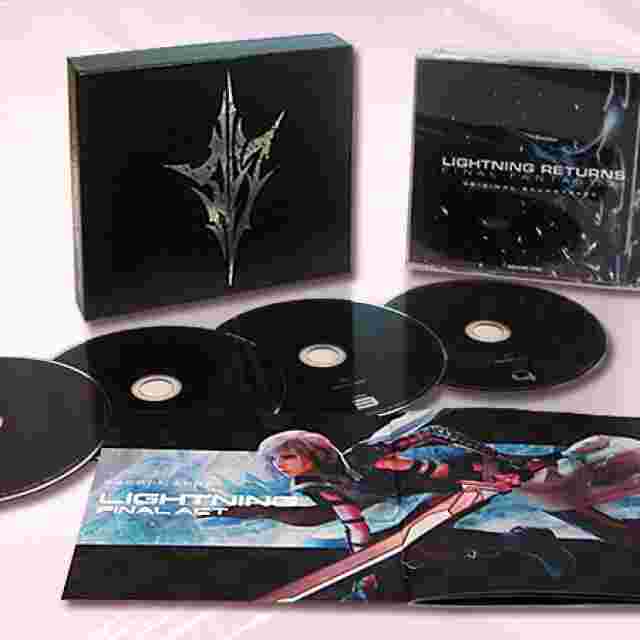
Also includes a flyer advertising FF13 Play Arts action figures and various other FF13-related merchandise. Some of those pictures are NOT found in the limited edition. The liner notes fit inside the slipcase and contain the tracklist in mixed Japanese (kana) and English, with their own English interpretations messages in kana from composer Masashi Hamauzu, director Motomu Toriyama, and producer Yoshinori Kitase lyrics to "Ragnarok," "Sunleth Waterscape," "Serah's Theme," "Chocobos of Cocoon," "Fighting Fate," "Choose to Fight," "Sulyya Springs," "Dust to Dust," "Born Anew," "Kimi ga iru kara" (long version) and "Eternal Love" (short version) a brief profile of Sayuri Sugawara and various CGI artwork of the characters and scenes from the game.

The case slides into a thin cardboard slipcase that has the FF13 logo on the front. The CDs come packaged in a fold-out cardboard case with various CGI artwork decorating the flaps and underneath the clear-plastic CD trays. The CD tray is clear plastic and the staff and cast credits are printed underneath. The liner notes are called a "Scenario Book" that has the audio drama's script in Japanese. It originally comes packaged in a silver foil wrapper, and the actual CD has clear plastic shrinkwrap. The bonus CD is an audio drama called "Episode Zero -Promise-: Story01 -ENCOUNTER-" in a separate jewel case. Also comes with the same merchandise flyer found with the regular edition, and a Square Enix point card. The CDs slide into a clear plastic slipcase that has the soundtrack name and catalog number printed on it. The lyrics to Sugawara's songs, along with the same profile of her found in the regular edition, are printed on the back inside flap. The lyrics to all the same songs as the regular edition are also printed underneath the CD trays. The CD trays are clear plastic with more CGI game scenes underneath them. The tracklist is the same as the regular edition and is printed on the inside flaps. The music CDs come in a fold-out cardboard case. It also most, but not all, of the same game screenshots as the regular edition, in addition to other CGI artwork and color illustrations by Yoshitaka Amano that are not found in the regular edition. The so-called visual book contains the same messages from composer Masashi Hamauzu, director Motomu Toriyama, and producer Yoshinori Kitase as the ones found in the regular edition. The liner notes are called a "Visual Book" and are just a bit smaller than the box and fit inside it. The limited edition comes in a glossy cardboard box measuring about 7.75 inches square and a little less than 2 inches deep. The back of the flyer has some kind of point value printed in the corner what it's used for, I don't know. The flyer is different from the one included in the Four Warriors of Light soundtrack. Included with the soundtrack is a flyer explaining the campaign for anyone who wants to try to translate it, here are scans of the front and the back. I have no idea what the details are, but it seemed to partially involve the SE point cards. Check Square Enix's official site for the soundtrack (all in Japanese) if you'd like to read comments from composer Masashi Hamauzu about his thoughts on each song.īoth the limited-edition and regular-edition CDs were part of a " soundtrack campaign" by Square Enix that ran from Dec. Soundtrack to the game Final Fantasy XIII for the Playstation 3. Miya Records (limited-edition style): MICA-1125-9 Regular edition catalog number: SQEX-10183-6 Limited edition catalog number: SQEX-10178-82

It’s for collectors and completionists only.Final Fantasy XIII Original Soundtrack - Daryl's Library - Final Fantasy CDs What’s important here is that people wanting some exciting new arrangements will be disappointed by this album. And at only 16 tracks, I can’t help but think there’s even more missing. I will say that I enjoyed “Lightning NW Version.” Very cool.Īnyone hoping for a proper arrangement of this music will be sorely disappointed though. And the “Long Version” of the battle theme? Didn’t mean much to me. I generally found the “alpha” versions to be more hollow, echo-y, and empty.

But only the most discerning listeners will catch the difference between the official OST versions of certain themes and the alternate versions found here. The new English language recordings were pretty cool (I especially appreciate Cocoon de Chocobo). But if you own the OST, you’re not going to get much out of this disc.


 0 kommentar(er)
0 kommentar(er)
